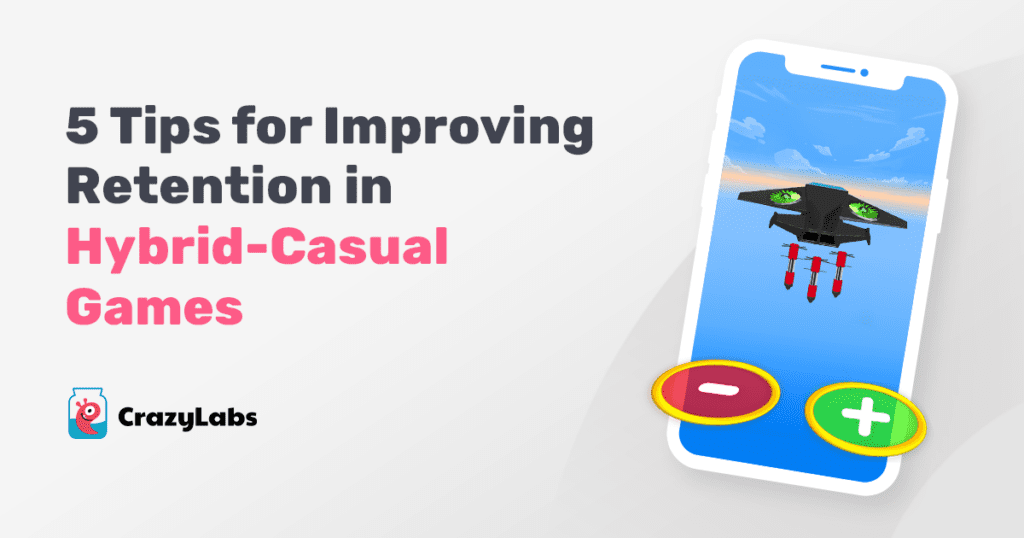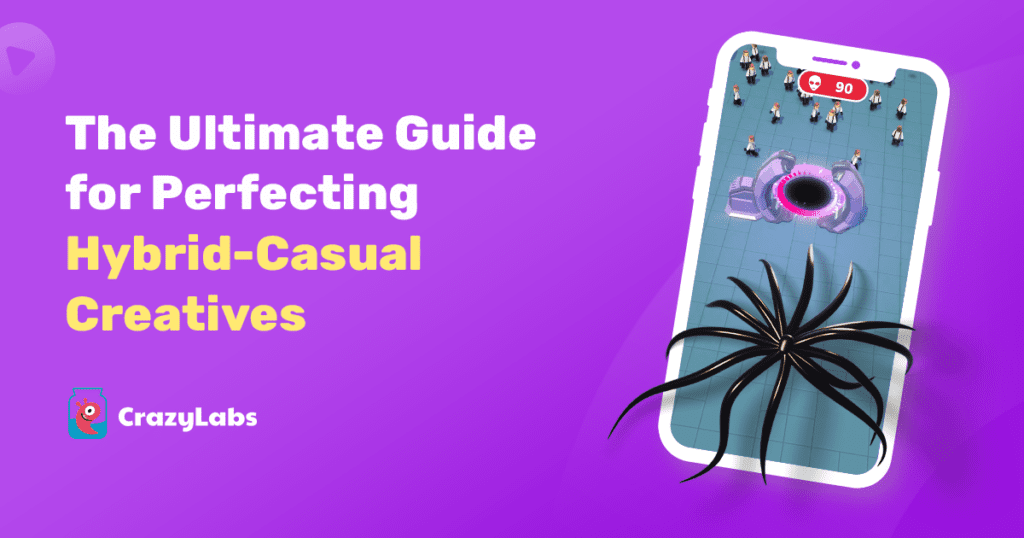Evolving Bombs, which was developed by the studio TapNPlay and CrazyLabs, has an interesting story. Despite being on the verge of cancellation in June 2023, the implementation of an incremental upgrade system and a progressive level-end feature saved the game, leading to its high success with millions of downloads.
Below, Evolving Bombs‘ Senior Game Owner, UA Manager, and CrazyLabs’ Monetization team share 10 key takeaways to apply to your next game.
Evolving Bombs Intro
The game is a classic runner game where the player controls either a cluster of bombs or a plane, navigating through mathematical gates, avoiding obstacles, and shooting enemies. The objective is to maximize the player’s score by choosing the right gates and progressing as far as possible to fight the bosses at the end of the level.
The game’s success can be attributed to four key updates:
- Introducing New Features: The combination of an incremental upgrade system, progressive level end, and a level end rewarded video offer enhances player engagement and motivation.
- Base Building Meta Feature: Added to maintain long-term player engagement.
- Runner Shooter Game Transformation: Transformed the game into a runner shooter, allowing players to control the plane at the beginning of each level, adding gameplay variety.
- Hangar Feature and Loot Box System: Introduced to complement the new runner shooter mechanic and provide a robust progression layer.
Key Takeaways
Incremental Upgrade System
This is a game mechanic that allows users to gradually enhance specific attributes of their character. These attributes can include level, count, width, length, income, fire rate, fire range, attack power, speed, and more. In the case of Evolving Bombs, the two attributes that could be incrementally upgraded were bomb count and bomb power.
This system plays a crucial role in building the game’s economy, as it has the potential to be the most significant sink point for soft currency (in-game currency earned through gameplay). When combined with a well-balanced game economy, the incremental upgrade system can create a high demand for soft currency. This demand opens up opportunities for monetization through ads and in-app purchases (IAPs).
By providing players with a sense of progression and the ability to customize their character’s attributes, the incremental upgrade system encourages long-term engagement and retention. As players invest time and resources into upgrading their character, they become more invested in the game, leading to a more satisfying and rewarding gaming experience.

Progressive Level End Feature
This feature is a separate segment that occurs at the end of each level, where the player’s character progresses by eliminating obstacles in their path. The gameplay during this segment often differs from the core mechanics experienced throughout the level. The distance the player can cover during the level end should be directly correlated to the character’s upgrade level, which the player can improve over time.
To maintain user engagement, the levels should be designed in a way that allows players to achieve a “high score” periodically during the level-end segment. By providing players with the opportunity to surpass their previous best performances, the game keeps them motivated to continue playing and improving their skills.
Implementing the progressive level end feature in this manner not only adds variety to the gameplay but also gives players a sense of accomplishment and progress.
Pro tip: Showcasing a prize or a boss at the end of the level end sequence can highly drive engagement and retention. This creates curiosity and gives users a purpose to keep playing the game and reach the level end prize or boss.

Level End Rewarded Video (RV) Offer
A common way to increase RV impressions in a game is to introduce a level end RV offer. This offer allows users to multiply their earnings after completing a level by watching an RV advertisement. While this practice is widely used, not all implementations receive high engagement. You may wonder why this discrepancy exists.
Although UI/UX differences in the level end RV offers can contribute to varying levels of engagement, the main differentiating factor is the economy setup. If there isn’t sufficient demand for the soft currency, a lack of soft currency sink points, or soft currency inflation, engagement with the level end RV offer will be low. A well-balanced game economy is crucial for the success of level end RV offers.
To create a balanced economy, ensure that:
- There is a genuine need for soft currency within the game.
- Players have lots of opportunities to spend their soft currency (sink points).
- The rate at which players earn and spend soft currency is carefully regulated to prevent inflation.
When these conditions are met, level end RV offers can work wonders for increasing RV impressions and improving overall game monetization. Therefore, prioritize designing a robust and balanced game economy before implementing level end RV offers to maximize their effectiveness and drive higher engagement.

Meta Feature
Introducing meta-game features is an effective way to keep players engaged over the long term and increase Day 7 and 14 Retention. In Evolving Bombs, we introduced a base-building feature where users can construct, upgrade, and fortify their base. Players can attack others’ bases to loot currencies, and can also be attacked by others. To protect their currencies, players must build fortifications like shields to defend their base. This social dynamic increased engagement with the base-building feature.
Pro tip: To increase engagement with the meta feature, ensure that the meta layer progression directly benefits the core gameplay progression. In the case of Evolving Bombs, players with a more upgraded base received a greater soft currency boost at the end of each level. This integration between the meta-game and core gameplay creates a synergistic relationship that encourages players to invest time and resources into both aspects of the game.

Changing the Core Gameplay
We made a bold decision to add a shooting mechanic to the core gameplay of Evolving Bombs. This decision was driven by two main factors:
- Shooter runners were on trend and known for creating more engaging and long-lasting game experiences.
- Introducing a shooting mechanic would enable us to implement more complex meta layers in the game, providing additional opportunities for user monetization.
By incorporating the shooting mechanic, we aimed to enhance the overall player experience and increase the game’s potential for revenue generation.
In our first iteration, we attempted to change the entire core gameplay by introducing a shooter runner mechanic. To implement this mechanic, we introduced the plane item, allowing players to steer the plane instead of the bomb cluster.
A gun was attached to the plane, automatically shooting new-level design elements like drones and armored drones. Additionally, mathematical gates now have a new feature where players can shoot at them. Each shot increases the number displayed on the gate. Additionally, bombs are attached to the bottom of the player’s plane. These attached bombs are still affected by the mathematical gates, modifying their properties based on the gate’s function. Next, two new gate types were added: fire rate and fire power, increasing the gun’s shot rate and bullet power, respectively.
All these changes meant removing the previous core mechanic where bombs dropped vertically from the game entirely. After releasing that version and gathering data, it became apparent that there were significant churn points, especially in the initial levels of the game, and the version wasn’t performing well. We concluded that removing the core gameplay entirely was not optimal for two important reasons:
- The mechanic of bombs dropping vertically is a unique feature of our game that sets it apart from other conventional runner games. This mechanic drives long-term engagement and retention.
- Most of the creative videos used to acquire users for the game incorporated that mechanic. Users were essentially hooked on that mechanic and naturally anticipated seeing it in the game. When they couldn’t find that mechanic, they churned from the game feeling cheated.
For the second iteration, we decided to tweak the core gameplay to incorporate both the shooting mechanic and the vertically dropping bombs mechanic. We designed the levels in a flow where users start by steering a plane that automatically shoots bullets at enemies and mathematical gates. Midway through the level, the bombs attached to the bottom of the plane detach, and simultaneously, the camera angle changes to a vertical view. At this point, the user starts steering the cluster of bombs that just detached from the plane, as they move vertically.
With this level of design approach, we ensured that users who were hooked on the vertically dropping bombs mechanic from our creative videos got what they were looking for. At the same time, we incorporated the shooting mechanic, which helped us create richer game experiences and appeal to a different user segment.
Pro tip: When implementing a major update to your game, ensure that you showcase these changes in your creative videos as well. By highlighting the new features and improvements in your marketing materials, you can positively impact both product and marketing metrics. This approach helps attract new players and re-engage existing ones.

Hangar Feature and Loot Box System
After integrating the shooting mechanic, our goal was to build comprehensive and progression-based meta features around it to bring more depth to the game. The first significant feature update was the introduction of the hangar feature and the loot box system. The hangar feature allows users to select the items they want to use during levels. Players can choose their desired items for each level either from the loadout widget on the main menu or directly from the hangar screen.
The items fall under three different categories: bombs, planes, and guns. As users progress through the core loop, they can unlock different items with varying qualifications.
They can spend soft currency and item-specific cards to upgrade their items, making them stronger and giving them a competitive advantage during the level. Users can open loot boxes to acquire item-specific cards used for upgrading items. The introduction of the hangar feature led to the removal of the previously mentioned incremental upgrade system, as it only included upgrades related to bomb attributes. The hangar feature serves as a more robust and comprehensive upgrade system, incorporating upgrades for plane and gun items as well, directly replacing the incremental upgrade system.
This complex system opened up many possibilities for the game. Firstly, users are curious to unlock different kinds of items, which is only possible through core loop progression. This curiosity element leads to increased usage and long-term retention. Secondly, users have the opportunity to strategically favor certain items depending on their playing style.
For example, users can choose a gun with a higher fire rate but lower firepower, or a gun with a lower fire rate but higher firepower, based on their preference. Lastly, this system provides an abundance of monetization opportunities. Loot boxes with different yield possibilities or special items with unique attributes can be sold as IAPs. Limited-time or seasonal offers can also be presented as IAP items.

Tailored Creative Strategies for Each Platform
The first step was to expand our presence across multiple platforms. However, to sustain scalability and profitability, we needed to develop a careful approach to creative development. Through rigorous testing of various styles, lengths, and end cards, we identified winning creative strategies tailored to each platform.
For example, on one media source, longer gameplay videos of 50-60 seconds combined with multi-click playable have significantly improved campaign performance. Another media source responded well to clickbait videos and end cards, leading us to integrate engaging elements like 20-second gameplay snippets followed by 10-second clickbait calls-to-action. In cases where video strategies were ineffective, we achieved another breakthrough by using longer standalone playables that showcased gameplay details. This approach helped us scale our presence in those particular markets.
Finally, social networks require a more creative approach, which was achieved via leveraging AI to produce engaging, trend-relevant content. Through these tools, we focused on creating short, humorous videos featuring gameplay voiceovers and mid-to-upper captioning that resonated with our audience on these platforms.
Embracing Localized and Regional Targeting
Although the US remains a primary market for mobile games, expanding our footprint in non-US territories presents significant growth opportunities. For Evolving Bombs, markets like Japan and South Korea emerged as key targets and therefore required a localized approach. We started by translating our best ads, including the text and call-to-action buttons, and followed with an adaptation of the store page for these regions.
We then developed entirely localized creative assets, covering videos, playables, images, and text assets. This localization strategy, including voiceovers and dynamic elements tailored to each region, has demonstrated immense potential across all networks. We then expanded this approach to include additional languages.

Strategic Ad Placement
To maximize revenue without compromising user experience, we carefully integrated ads (rewarded videos, interstitials, and banners) into the game’s natural flow, as mentioned above. We were meticulous about ad placement to enhance the user experience and prevent disruption.
Banners only appear during gameplay, not on main pages, ensuring players focus on the core content. Similarly, interstitials and rewarded videos are placed at strategic moments, such as between levels or after achievements, to avoid interrupting gameplay.
Striking a balance between monetization and user satisfaction is key, and strategic ad placement plays a crucial role in achieving this. By properly integrating ads into the game’s flow, we can maintain a positive user experience while effectively monetizing the app.


In the daily reward section, users can unlock the next day’s reward faster by watching an RV.
Incentivized Gameplay
To encourage deeper player engagement, Evolving Bombs offers rewards for challenging achievements. At the end of each level, players can choose to watch a RV for the opportunity to battle a boss enemy.
This strategic RV placement creates a more engaging and rewarding experience by allowing players to extend their gameplay and test their skills against a powerful opponent. By providing players with the choice to engage with the RV, the game successfully drives monetization while enhancing the overall player experience. Here’s an example of this particular RV:

Over to you – apply these valuable learnings to your next mobile game.


